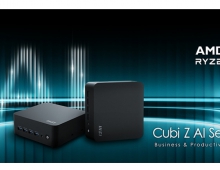MSI FX5950Ultra
6. Aquamark 3
MSI FX5950 Ultra - Page 6
Aquamark 3
 Since
the majority of today's applications and games are compatible with DirectX
9, the need for benchmark applications that use DX 9 has been brought up.
The benchmark uses the 3D engine (Krass engine) from the Aquanox game.
Since
the majority of today's applications and games are compatible with DirectX
9, the need for benchmark applications that use DX 9 has been brought up.
The benchmark uses the 3D engine (Krass engine) from the Aquanox game.
Unlike synthetic benchmarks, Aquamark3 allows benchmarking in a real-world scenario with an engine and art assets representing the complexity of current state-of-the-art games. The results you get from Aquamark vary from a general result score (AquaMark Triscore), which is a result of 9 chapters each one utilizing different graphical operations. The AquaMark3 benchmark also delivers scores for specific hardware components, as well as an overall score for the entire system.
The chapters that stress the Graphics performance are the following:

In this section we present comparison charts for the following chapters: High particle count, Vertex and Pixel Lighting and Massive Overdraw
- High particle count
 This chapter demonstrates a high number of particles being used for simulating dust and smoke. Each particle is approximated by a mass point with one degree of freedom for its rotation.
This chapter demonstrates a high number of particles being used for simulating dust and smoke. Each particle is approximated by a mass point with one degree of freedom for its rotation.
The particle system in this test is designed to render a large number of
natural, accurately simulated particles as efficiently as possible.
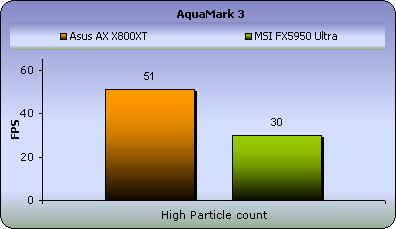
Complicated particles in great numbers were a big challenge for previous GPUs to deal with. But with the latest chipsets released, this is not an issue any more. And as you can see from the above results, there is a big difference between the 2 generations.
- Vertex and pixel lighting
 The
objects in this scene show a broad range of different material and lightning
effects used in modern gaming engines.
The
objects in this scene show a broad range of different material and lightning
effects used in modern gaming engines.
Aquamark3 tests two things: It applies many vertex and pixel shader changes
straining the graphics hardware and its many texture lookups (determining the
lighting contribution and material reflectivity) and also strains the Multitexturing
and rasterization components.
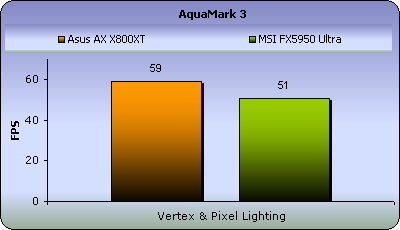
Since the release of the Radeon and FX cards, the Vertex and Pixel lighting techniques have been used to greater extent, offering a new perspective on graphics. This part of the Aquamark benchmark renders complicated lighting effects, the very same used in games. We can see excellent performance from MSI's card with only 8 FPS difference from the X800XT.
- Massive Overdraw
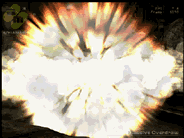 This
scene demonstrates the application of the particle system for large explosions.
The test stresses the graphics hardware with high overdraw of textured
areas, since many particles overlap each other. A huge explosion that is included
in
this chapter, pushes the VGA card to the limits. It's really awesome if you
imagine the number of pixels and shaders needed to make such an explosive
scene.
This
scene demonstrates the application of the particle system for large explosions.
The test stresses the graphics hardware with high overdraw of textured
areas, since many particles overlap each other. A huge explosion that is included
in
this chapter, pushes the VGA card to the limits. It's really awesome if you
imagine the number of pixels and shaders needed to make such an explosive
scene.
This is an important test, because the explosions in games require a lot of vertex and pixel processing. In many games when an explosion occurs, this causes frames to drop suddenly at that particular moment. So this test is a simulation of what to expect from your card when facing explosions and other similar effects in games.

- Aquamark Triscore
The Aquamark Triscore comprises 3 values: the overall system performance, the performance of the graphics system and CPU performance. Keep in mind that this is not the total result of the above tests, but the result of the whole benchmark process including all 9 chapters.
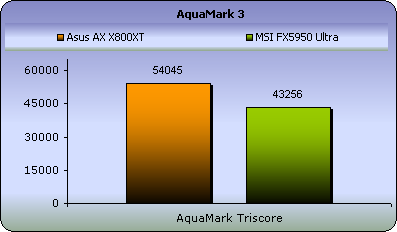
The total Triscore for the MSI card is disappointing. 43256 would be fine for an FX5900XT powered VGA card but not for the Ultra version. We were expecting much more. Let's move on to the Codecreatures benchmark.

